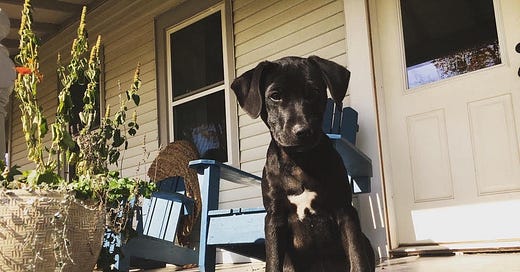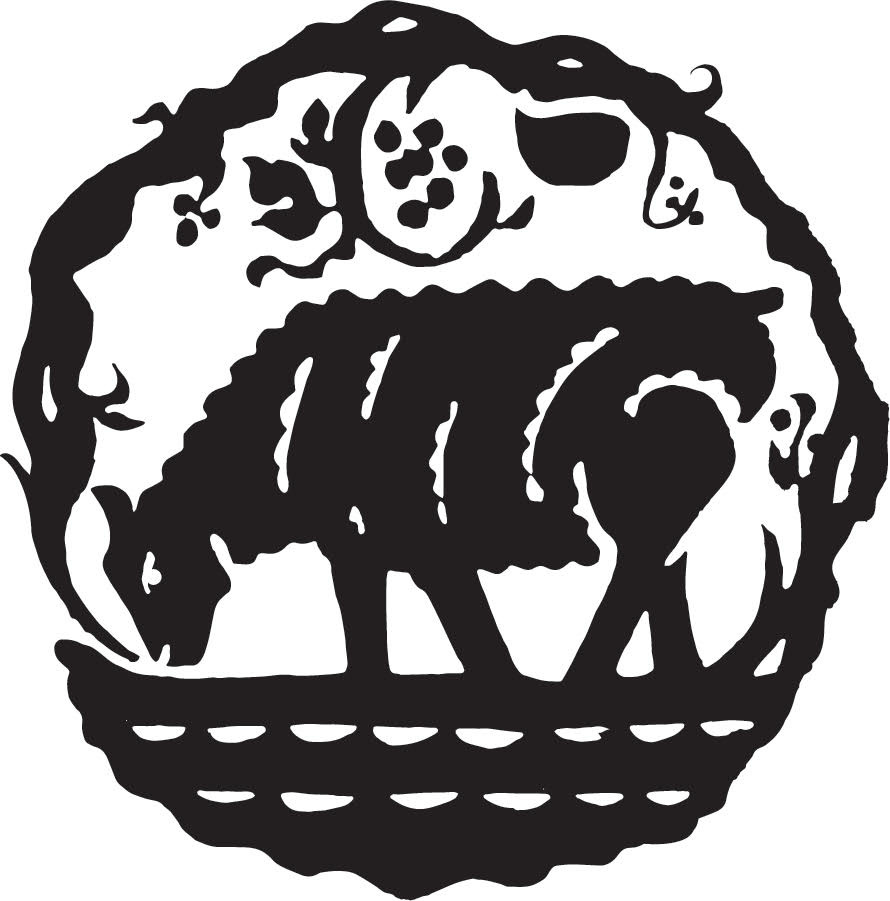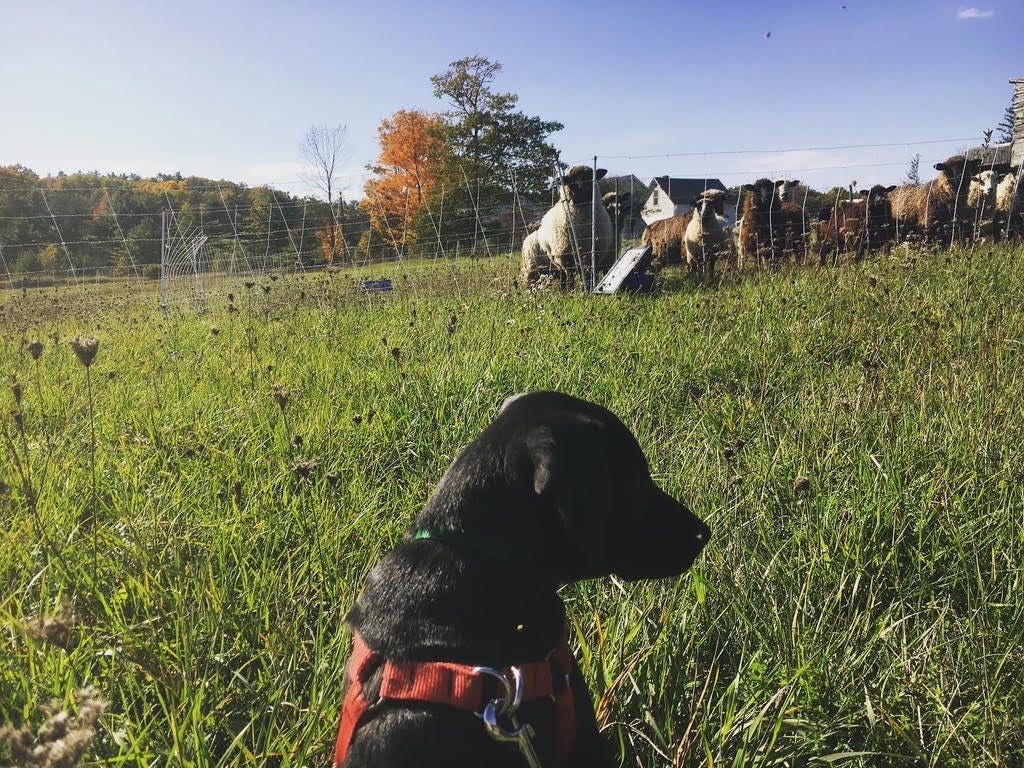Autumn 2022 Newsletter
Hello!
It’s been such a full season I don’t even know where to begin. I guess the biggest change in our lives came just a few weeks ago, when we picked up our new pup, Shaggy. He came to us from a rescue organization based in Alabama, and while it felt like a gamble to commit to adopting a dog without having ever met him, it seems like we struck gold. He is sleeping at the moment—so far he loves napping and sleeping in his crate, which makes it very easy to bring him to Echo Farm with us, during our work days. He loves meeting new people and new dogs, and so far, seems neutral about the sheep. He is very curious about our cats but is learning to sit quietly and let them come to him.
I’ve never had a dog before—I’ve lived with some, but never had the whole weight of the responsibility of bringing up a respectful, obedient and well-mannered dog. It is crazy to watch him learn and grow. Some days I am very excited and hopeful and see lots and lots of progress already in just a few weeks. And some days are hard, and I get overwhelmed with the responsibility. However, he has fully captured our hearts and we are both committed to working through the challenging times with him.
This fall, we also have been preparing for our first in-person sales event, which is coming up on October 29 at the Strand Theater in Plattsburg. All summer I’ve been weaving and making many smaller items like zipper pouches and small tapestries, that people may be willing to impulse buy, which we will have for sale in addition to our blankets and wraps. I am excited to get out there and talk about our farm and sheep and to make connections with our community. Once the in-person markets are over, I will be updating our online Etsy store with inventory to be ready for holiday sales. If any of you are local, please consider coming out to do some gift shopping from local artisan vendors! And if you are not local, stay tuned for our online sales.
Speaking of online, this summer my talented sister put together a website for us. Check it out at www.wollecru.com. We had a photographer friend stay with us in June, and she captured some wonderful moments around the farm. Taylor and I practiced our composition skills to write some paragraphs about what we do and why, and my sister put it all together. A friend of mine from growing up, Walker Crane, designed a logo for us—so it feels like the branding and communication about our farm is all coming together. The website for now is static, with a link to our Etsy shop as we continue to learn what our best sales channels will be.
our new logo!
The sheep are doing really well. I only had one lamb get worms this summer, otherwise clean bills of health for everyone. While we do our best to mitigate worm load in the sheep by moving them everyday or every other day, our grazing rotation has proved to be a little tight, and we are returning to pastures earlier than it would take for the sheep parasites to die from having no hosts. While this isn’t a big deal for our mature ewes who have built up a tolerance to many parasites, sometimes a lamb gets overwhelmed, especially right around the time their mamas are weaning them off milk, when they are about 4 months old. This weaning stress mixed with untested immune systems can make them susceptible to having a flush of internal worms. We don’t see the worms—instead the symptom of a wormy lamb is this curious condition called “bottle jaw.” Basically, fluid builds up in the sheep, and since they spend a lot of time grazing with their head down, the fluid collects under the chin and jaw. I noticed one of Peggy’s triplet lambs, Pepper, with an oddly inflamed head one afternoon. I caught her and inspected closer, and she was definitely inflamed in the jaw and cheeks. I gave her a dose of de-wormer and let her go. The next day I could see the inflammation had gone down, and by two days later she looked back to normal. I’m glad I caught her early, and it was a good reminder to spend some time just observing the sheep every day to catch little nuances like that.
To help us have longer rest periods for our pastures, we began this year opening up more fields that the forest has been slowly trying to reclaim. Our property has 10 acres of hay fields which have been cut and maintained, however there are probably about 10 more acres of old pasture that will take a few years to get back to being really productive. It is pretty easy for us to see these old fields, as these areas have grown back in with mostly buckthorn, honeysuckle, young pines and a bit of native dogwood, all surrounded by lots and lots of goldenrod. While I do love the look of a full field of goldenrod in the autumn, I also am excited by how quickly just having sheep grazing, one mowing per year, and frost seeding grasses and legumes in the late winter can transform those golden rod monocultures into diverse and thriving pastures, which will grow up and get eaten maybe two or three times in one season. That constant active growth pumps carbon through the roots and into the soil to be long term, stable carbon holding. We will always leave some goldenrod though, as it is a joy to hear and see the hum of late autumn bumble bees collecting pollen in the fields.
Another benefit of these old fields is that the abundance of buckthorn and honeysuckle can be maintained in these new pastures as tree fodder for the sheep. Sheep LOVE to eat the leaves of these two invasive species. A SARE study came out this year analyzing the nutritional value of these species as fodder for grazing animals, and they found that both were high in crude protein and many macro and micro nutrients such as calcium and iron (https://projects.sare.org/project-reports/fne19-930/). In fact, when moving the sheep through these areas, they first went and ate all the buckthorn they could reach, before exploring any of the grasses or legumes in the paddocks. All summer we’d go out with loppers and cut the shrubs down to about waist height so that the sheep could eat the tall branches, and so that next season when they sprout, the new growth will all be at sheep-height. We hope to continue to manage forage shrubs like this throughout all our pastures by also intentionally planting some forage species such as willows, dogwoods, and locusts. These increase the diversity of the sheep’s diet, provide pockets of shade wherever they are, and give more habitat to birds and insects throughout the whole property.
Earlier in the summer we did a big excavation project to bring water lines out to both barns. We quickly set up some above ground lines to move water out to the pastures, so that all summer the sheep were on automatic waterers, which sure beats carrying 5 gallon buckets of water all around! I am also looking forward to having easy access to water at the barns all winter long. No more filling up buckets in the bathtub.
Garden-wise we spent a good part of the summer constructing a patio garden, where we will have an outdoor cooking area. Since the farmhouse has had 200 years of lead paint on its exterior, I knew I couldn’t have any herbs or edible plants around the house. So this area will be the focus of an herb and kitchen garden, and hopefully be a place where we will spend many summer evenings. We planted many fruit trees and grapevines this spring, and while they all started the year out great, first the spongey moths, then the Japanese beetles really did a number on them. I don’t think the insect pressure killed anything, but they did knock things back. We’re hoping that as our plants become more established they will fare better when they are under attack. And we can only hope for a cold spring to knock back the spongey moths, who have been wreaking havoc all over the Champlain Valley for the last two years. I’m looking forward to spending some time this winter picking out more trees and vines to plant next spring—we definitely want to plant more pears, as for some strange reason all the pear trees that we currently have grew magnificently this year.
the patio garden under construction in August
In addition to the water project, we decided to make an investment in some proper sheep handling equipment. We got portable corral panels, raceway panels, and a sorting gate. This allows up to set up a corral anywhere on the farm, run the sheep through and either catch and hold them for treatment or checkups, or to sort them into different groups with the gate. In fact, in just a few days we will be doing our last big sort of the season, to take out the ewe lambs who I don’t want to get bred this season out of the ewe flock, put them with the wethers, and to sort the ram out of the wethers and put him in with the ewes who will get bred. Our plan is to join the ram to the ewes at the beginning of November, so that we will expect our first lambs at the beginning of April.
The other big upgrade that we made this season was on the weaving front. I’ve come to understand that in order to bring our prices down and have more affordable products, there are technological upgrades that I could make to have a more time efficient weaving process. I’d been keeping my eye out on used fiber equipment listings, and at the end of September a loom came up for sale in Maine that I’m calling the “ultimate loom.” As in, Taylor, I promise I will never need another loom again... It has a 60” weaving width, which is wide enough to weave bed sized blankets if I ever wanted to. It has a sectional warp beam, which will allow me to put warps on that are…as long as I want. I’m thinking I will try 30 yards to begin with and see how that goes. (My current setup maxes out at 10 yards). It has fly shuttle boxes, which means instead of throwing the shuttle for every pick, with a flick of my wrist the shuttle will fly and the weft yarn will lay with the correct tension. It has an automatic cloth advance, which means I could sit down and weave until the warp runs out, and never have to stop to rachet the cloth forward. It is a dobby loom, so instead of tying up and then treadling a pattern sequence, I will set the pattern into the dobby and then weave with only two treadles. As I write this, part of me is a little sad, because running the treadles, throwing the shuttle, advancing the cloth is all what weaving is—its those motions that I love and find rhythm in as I work. However, I will keep my current looms for smaller projects and sampling, and I think that in time I will learn to love the motions and rhythms of this new loom too. What it really means is that I will be able to weave more efficiently, which I hope will make sales easier and more achievable for us in our local market. For now the loom is all in pieces in the upstairs hallway. Once I get our next batch of wool back I know I will be itching to set it up.
One final thought that brought up for me--anyone who is local and might be interested in a 6 week weaving lesson, please get in touch. I have two looms which I acquired in order to be able to teach weaving, and I think this winter I'd like to try it out with one or two students.
So much more to write about, but this is long enough for now. Hope you are all ready for the slower, darker months of winter—we sure are. If you want to stay in touch, follow me on Instagram at @kirstenliebl, and feel free to email me if you’d like to purchase anything or just say hi. Til next time!
Kirsten and Taylor (and Shaggy and the flock)








